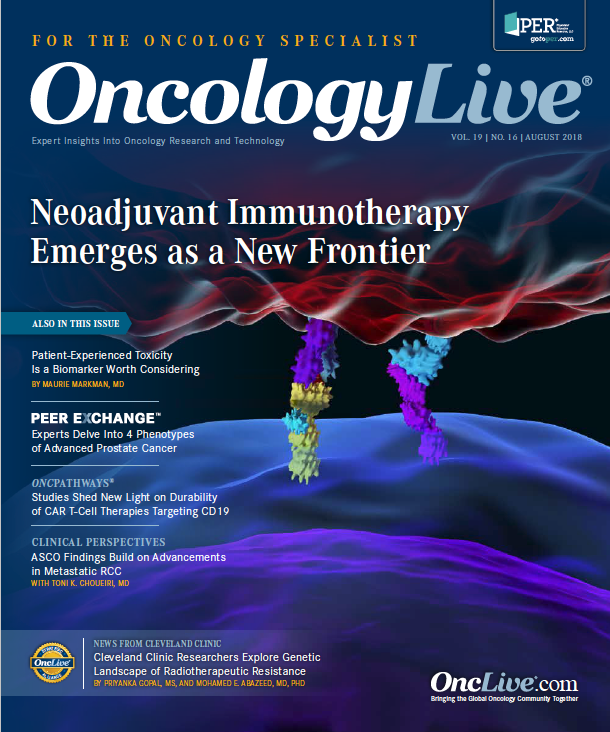Patient-Experienced Toxicity Is a Biomarker Worth Considering
Maurie Markman, MD, says that the acceleration in regulatory agency approvals for novel antineoplastic agents and the focus of biomarker discovery proves that this is the era of precision medicine.
Maurie Markman, MD

Maurie Markman, MD
The era of precision medicine is upon us. Doubters should note the acceleration in regulatory agency approvals for novel antineoplastic agents for which clinical activity is defined by a specific molecular abnormality or at least a well-characterized constellation of biological events (eg, microsatellite instability—high). These identify patients with a probability of attaining clinical benefit from particular approaches to disease management.
The essential component that permits the process of precision medicine to achieve a successful outcome is the discovery and subsequent validation of a biomarker that, by its presence or absence, has been demonstrated to be predictive of a particular strategy’s utility.
Today, the focus of biomarker discovery is on abnormalities present within the cancer itself or germline events (eg, BRCA mutations) that will predict for the biological and clinical activity of a given antineoplastic agent. It is reasonable to speculate that, in the future, unique signatures found within a given patient’s germline will also be used to identify individuals who may have a meaningfully greater probability of experiencing a clinically relevant toxicity (eg, neuropathy and stomatitis) from a particular drug or class of drugs. This may permit the selection of an equally active regimen that does not cause the toxicity. Unfortunately, such testing remains largely an investigative strategy with still-undefined utility in routine oncology practice.
Although employing molecular biomarkers to predict the risk of toxicity is not the generally accepted standard of care in oncology, it should be acknowledged that the toxicity experienced by a patient may provide a biomarker in the future management of that individual. The choice of agents based on toxicity biomarkers would be quite independent from the currently routine management decision on the need for a dose reduction or treatment delay or the requirement for drug discontinuation.
In an increasing number of clinical settings, the continued delivery of effective antineoplastic therapy to patients with advanced cancer can result in prolonged remissions—measured in years, not merely months. The question now is whether it is appropriate to discontinue active therapy based on the realistic possibility that the patient will remain in remission indefinitely or at least experience a relatively long treatment-free interval. Two settings where this issue is being actively addressed are (1) patients with chronic myelocytic leukemia who experience prolonged deep responses following treatment with tyrosine kinase inhibitor therapy and (2) the attainment of a similar clinical state in metastatic melanoma after checkpoint inhibitor delivery.1,2
The critical issues here are whether the reintroduction of therapy (if necessary at the time of subsequent disease progression) will succeed in achieving a second major response and whether the elective discontinuation of therapy will compromise the patient’s ultimate survival.
Of course, the answers will not be known at the time an individual considers stopping an objectively highly effective antineoplastic regimen. It is reasonable to suggest, however, that the unique toxicity experienced by that patient and the impact of adverse effects (AEs) on the patient’s overall quality of life should play a relevant role in this decision-making process. The patient who has been fortunate to have faced few symptomatic AEs or none at all may be less inclined to consider discontinuing active therapy, as opposed to the individual whose quality of life has been negatively affected (eg, therapy-related neuropathy or fatigue) notwithstanding the benefits attained through disease control (eg, disappearance of cancerinduced pain or anorexia).
Ovarian cancer is another setting where the toxicity experienced by an individual patient may serve as a useful biomarker when selecting subsequent therapy. Consider the case of a hypothetical patient who has experienced recurrence of disease after attaining an excellent but, unfortunately, relatively short-lived response to carboplatin-based cytotoxic therapy (eg, clinical complete response but documented progression 10-14 months after completing first-line treatment). If the prior carboplatin- based treatment had been reasonably well tolerated (eg, minimal or no emesis and no neuropathy), it might be appropriate to reintroduce carboplatin to see if a second response can be attained. Conversely, if the prior chemotherapy had been associated with a similar degree of efficacy but also meaningful symptomatic toxicity, it might be most reasonable to consider an alternative to carboplatin.
A second example in which AEs might offer a biomarker is the management of recurrent ovarian cancer, for which 2 classes of antineoplastic agents, with differing toxicities and administration schedules, have received regulatory agency approval in similar clinical settings.
Both bevacizumab (Avastin) and 3 PARP inhibitors may be employed as a maintenance strategy following a response to second-line platinum-based therapy. However, initially, bevacizumab is routinely delivered along with the chemotherapy and then continued as a single-agent maintenance strategy. In contrast, the PARP inhibitors are not started until after a response to chemotherapy is observed and it has been decided to discontinue the cytotoxic regimen.
Therefore, when deciding whether to employ single-agent bevacizumab or a single-agent PARP inhibitor for second-line ovarian cancer maintenance, one consideration might be whether the AEs experienced by the patient may reasonably be ascribed to the antiangiogenic drug (eg, treatment- related, difficult-to-manage hypertension or the presence of significant proteinuria). A number of factors would certainly be discussion-worthy in the patient—physician consult, including the presence of a documented BRCA mutation, a patient’s desire to stop required office or hospital visits for treatment delivery, and the degree of insurance coverage and co-pay requirements for systemic versus oral antineoplastic therapy.
References
- Saussele S, Richter J, Guilhot J, et al; EURO-SKI investigators. Discontinuation of tyrosine kinase inhibitor therapy in chronic myeloid leukaemia (EURO-SKI): a prespecified interim analysis of a prospective, multicenter, non-randomised, trial. Lancet Oncol. 2018;19(6):747-757. doi: 10.1016/ S1470-2045(18)30192-X.
- Robert C, Ribas A, Hamid O, et al. Durable complete response after discontinuation of pembrolizumab in patients with metastatic melanoma. J Clin Oncol. 2018;36(17):1668-1674. doi: 10.1200/JCO.2017.75.6270.




